CPU Intel Core The i3, Core i5 and Core i7 have been on the market for over a year now, but some buyers are still stumped when choosing between these three processors.
Now new processors with Sandy Bridge architecture and buyers again have a question, which one is best for them? Let's make a comparison and look at the difference between the i3 i5 i7.
The difference between core i5, core i3 and core i7 in a nutshell
If you want to answer this question simply and clearly, then the Core i7 is better than the Intel Core i5, which in turn is better than the i3.
The Core i7 does not have seven cores, and the Core i3 does not have three cores. These numbers simply indicate their relative processing power.
Their relative level of processing power is calculated from their stars: Intel will help you with this, which is based on a combination of criteria: number of cores, clock speed (in GHz), cache size, as well as some new Intel Turbo Boost and Hyper-Threading technologies.
The i3 has three stars, the i5 has four stars and the i7 has five stars. If you are wondering why the rating starts with three stars, then the entry-level ones are Intel Celeron and Pentium processors - they received one and two stars, respectively.
Note: Core processors can be grouped in terms of their target device, i.e. and for desktop computers.
Each of them has its own specific features/characteristics. Note also that we will focus on 2nd generation processors (Sandy Bridge). Now in more detail how i5 differs from i7 and from i3.
Number of Cores
The more cores, the more tasks (threads) can be submitted at the same time. How many cores does i3 have? The Core i3 processor has the smallest number of cores; it has only two cores. Currently all i3s are dual core processors.
Now all Core i5 processors, with the exception of the i5-661, are quad-core. Core i5-661 dual core processor With clock frequency 3.33 GHz. Remember that all major i3s are also dual core.
Advice: The i3-560 also has a clock speed of 3.33 GHz, but it is much cheaper than the i5-661.
But even if the i5-661 normally operates at the same clock speed as the Core i3-560 and they have the same number of cores, the i5-661 has a huge plus - Turbo Boost technology.
Intel Core i7 processors have 4 or 6 cores.
Intel Turbo Boost
Intel Turbo Boost technology allows the processor to dynamically increase its clock speed whenever the need arises.
The maximum amount that Turbo Boost can raise the clock speed at any given time depends on the number of active cores, current power consumption and processor temperature.
For Core i5-661, the maximum permissible processor frequency is 3.6 GHz. Since none of the Intel Core i3 processors have Turbo Boost, the i5-661 can outperform them when needed.
Because all Core i5 processors are equipped latest version This technology - Turbo Boost 2.0 - all of them can outperform any of the Core i3 family.
Cache size
Whenever the processor detects that it is using the same data over and over again, it stores that data in its cache. Cache is the same as RAM, only faster - because it is built into the processor itself.
RAM and cache are used in waiting areas for frequently accessed data. Without them, the processor will have to read the data, which will take much longer.
Basically, RAM minimizes interaction with the hard drive, while cache minimizes interaction with RAM.
Obviously, the larger the cache, the more data can be retrieved quickly. All Core i3 processors have 3 MB cache, all i5 except 661 (4 MB) have 6 MB cache.
Finally, all Core i7 processors have 8MB of cache. This is one of the reasons why the i7 is superior to the i5 - and why the i5 is superior to the i3.
Hyper-Threading
Strictly speaking, only one thread can be fed to one core at a time. So if the processor is dual core, then only two threads can be fed at a time.
However, Intel has Hyper-Threading technology. It allows one core to serve multiple threads.
For example, a Core i3 is a dual-core processor, but each core can actually handle two threads, meaning four threads can run simultaneously.
Intel core i5 processors have four cores, but unfortunately they do not support Hyper-Threading technology (again, with the exception of the i5-661), so it turns out that the number of threads they can simultaneously service is equal to the number of threads on the Core i3.
This is one of the many reasons why i7 processors are the best. This is because not only do they have four cores, but they also support Hyper-Threading.
Thus, a total of eight threads can be processed simultaneously. Combine that with the 8MB of cache and Intel Turbo Boost technology they have, and you can see what sets the Core i7 apart from its peers.
Another factor in this comparison is that more and more programs support multithreading. That is, they can use more than one thread to execute a single command to speed up execution.
Some photo editors and video editing programs are multi-threaded. However, Internet browsers do not use multithreading and are unlikely to do so in the foreseeable future.
Who needs a Core i3 processor?
People who use their computer for word processing, email, web surfing, etc., a Core i3 processor is more than enough to handle it all with ease.
The Core i3 processor is 100% affordable for the vast majority of users.
Who needs a Core i5 processor?
If you love editing videos and gaming, as well as word processing, surfing the Internet and reading email, Core i5 processor is for you.
It has enough performance to do this sort of thing for a mid-range price.
Who needs a Core i7 processor?
As mentioned earlier, an i7 processor is not necessary for the vast majority.
But if you need crazy speed, then the i7 is your choice. If you are an avid overclocker, then the Core i7 is just for you.
Conclusion
Having compared the processors, we have come to the conclusion that, regardless of your choice of Core i3 or Core i5 or Core i7 processor, rest assured that you will get the best performance and high quality from processors of this series.
All three Core I-series are valued all over the world and the main differences are the number of cores, multitasking and of course, price.
I advise you to buy a computer that suits your needs within your budget.
Intel Core i3 and i5 processors for LGA1150
Last time we tested Intel Celeron and Pentium processors for LGA1150. The results made a dual impression: on the one hand, the performance of the processor part is quite consistent with the modern budget level, on the other hand, two computation threads are already not enough for many modern programs (in the sense that they can use more, accelerating accordingly). And the graphics core, even if it has “grown up” compared to the previous generation, still remains too weak to play more or less modern games at least at minimum settings and with a reduced resolution.
What happens if you pay extra? The question is not idle, since the value of money has increased slightly over Lately, so the question of the price of processors again begins to matter, which has been greatly devalued over the last decade. In addition, functional features modern computers already very weakly dependent on central processors, satisfying many users even within the budget segment, so additional costs only lead to the fact that everything becomes a little faster. We will try to estimate the magnitude of this “slightly”.
Test bench configuration
| CPU | Intel Core i3-4130 | Intel Core i3-4370 | Intel Core i5-4460 |
| Kernel name | Haswell | Haswell | Haswell |
| Production technology | 22 nm | 22 nm | 22 nm |
| Core frequency std/max, GHz | 3,4 | 3,8 | 3,2/3,4 |
| Number of cores/threads | 2/4 | 2/4 | 4/4 |
| L1 cache (total), I/D, KB | 64/64 | 64/64 | 128/128 |
| L2 cache, KB | 2×256 | 2×256 | 4×256 |
| L3 cache, MiB | 3 | 4 | 6 |
| RAM | 2×DDR3-1600 | 2×DDR3-1600 | 2×DDR3-1600 |
| TDP, W | 53 | 54 | 84 |
| Graphic arts | HDG 4400 | HDG 4600 | HDG 4600 |
| Number of GPs | 80 | 80 | 80 |
| Frequency std/max, MHz | 350/1150 | 350/1150 | 350/1100 |
| Price | $136 () T-10482934 |
$158 () T-11000559 |
$213 () T-10820134 |
Two Core i3 and one Core i5 models will help us with this. With the first, everything is simple - these are the same two computing cores as in Celeron/Pentium, but capable of performing four threads of calculations thanks to support for Hyper-Threading technology. The number of graphics pipelines has also doubled, and there are no restrictions on video technology support in this family - in general, this is a “more mature” option. Models 4130 and 4370 are just two opposite ends of the range: in the first case, the minimum frequency for “regular” Core i3, 3 MiB of L3 cache and a low-end GPU, while the second is the maximum in frequency (3.8 GHz is quite serious) , both in cache memory (full 4 MiB L3), and in graphics. But this processor is quite expensive, so it almost overlaps with the younger Core i5-4460: the same graphics, low frequency, but there are already four “full-fledged” cores - a more efficient scheme than 2+HT.
| CPU | Intel Pentium G3460 | Intel Core i5-3427U | AMD A8-7600 | AMD A10-7800 |
| Kernel name | Haswell | Ivy Bridge | Kaveri | Kaveri |
| Production technology | 22 nm | 22 nm | 28 nm | 28 nm |
| Core frequency std/max, GHz | 3,5 | 1,8/2,8 | 3,1/3,8 | 3,5/3,9 |
| Number of cores (modules) / threads | 2/2 | 2/4 | 2/4 | 2/4 |
| L1 cache (total), I/D, KB | 64/64 | 64/64 | 192/64 | 192/64 |
| L2 cache, KB | 2×256 | 2×256 | 2×2048 | 2×2048 |
| L3 cache, MiB | 3 | 3 | — | — |
| RAM | 2×DDR3-1600 | 2×DDR3-1600 | 2×DDR3-2133 | 2×DDR3-2133 |
| TDP, W | 53 | 17 | 65/45 | 65/45 |
| Graphic arts | HDG | HDG 4000 | Radeon R7 | Radeon R7 |
| Number of GPs | 40 | 64 | 384 | 512 |
| Frequency std/max, MHz | 350/1100 | 350/1150 | 720 | 720 |
| Price | $82 () T-10998994 |
— | $106 () T-10674782 |
$154 () T-10674780 |
With whom to compare? Of course, we will need the senior Pentium G3460, tested last time. Another processor of the previous generation, namely the Core i5-3427U, is a guest from a completely different segment: it is a CULV model, usually found in laptops and mini-PCs. But this is what makes it interesting - after all, the question of what to buy: a full-size computer or some kind of NUC (the 3427U was just tested as part of one of the modifications of the latter) arises for many people. And two AMD models - A8-7600 and A10-7800. It is clear that the Pentium graphics were not up to the A6, but today we have more serious (and expensive!) Intel models participating, so it is not interesting to compare with the A6. But with modern A8 and A10 - quite well.
As for other testing conditions, they were as close as possible to those recommended by the manufacturers. Those. AMD processors tested with TDP set to 65 W, RAM at maximum mode for all except the Core i5-3427U: there were no SO-DIMM modules suitable for it, so DDR3-1333 was used.
Testing methodology
To evaluate performance, we used our performance measurement methodology using benchmarks and . We normalized all testing results in the iXBT Notebook Benchmark v.1.0 relative to the results of a Pentium G3250 with 8 GB of memory and an Intel 520 240 GB SSD, and the methodology for calculating the integral result remained unchanged. Another program that, like last time, we added to the test set is the Basemark CL 1.0.1.4 benchmark, created to measure the performance of OpenCL code.
iXBT Notebook Benchmark v.1.0
Four threads on two AMD modules in this resource-intensive task is approximately equal to four threads on two Intel cores in the minimum version: the high-frequency i3-4370 is even faster. However, we are not talking about direct competition with quad-core models - although the i5-4460 has a low frequency, it outperforms the best Pentiums by more than twice, and the younger Core i3 and non-top A8/A10 by one and a half. Here is the level of ultrabook Core i5 - only Pentium. Which, however, is not so bad for those who care about the space occupied by the system or its autonomy :)
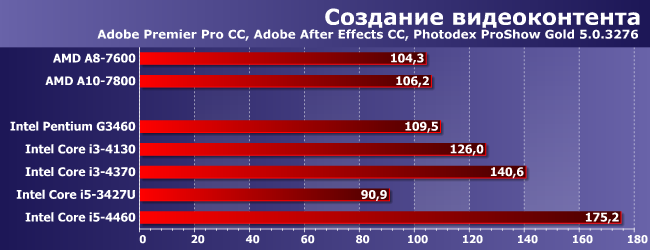
But not all programs need so many computation threads, and the further we move out of narrow niches towards mass-produced software, the more often this is observed, so the advantages of multi-cores or, at least, multi-threading may dry out. But don’t worry too much - don’t forget that the younger Core i3 and i5 have lower frequencies than the Pentium, but this doesn’t help the latter too much. AMD processors are in an even worse position - it wouldn’t hurt for them to break away from ultrabook Cores more significantly, or to overtake the desktop Pentium :)
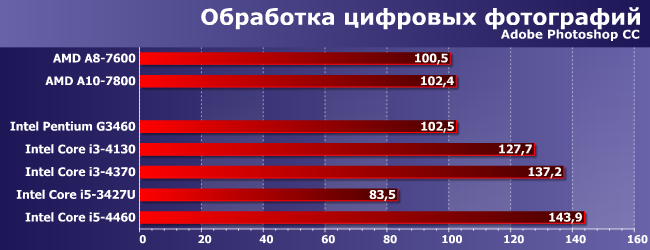
Photoshop, as we already wrote, still reacts poorly to additional x86 code streams, but it already rates the ability of processors to execute OpenCL quite highly. However, this doesn’t help the “APU ideology” much - it’s still only the Pentium level, and the Core is obviously faster than it. Tabletop ones, of course, but it doesn’t really matter which ones. So the maximum gain actually comes from Core i3.
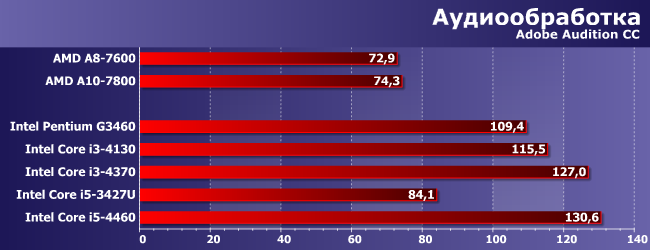
Two streams are two streams. With weak attempts to use more, which allows the younger Core i3 and i5 to outperform the Pentium and Core i3 running at higher frequencies, respectively, but nothing more. And the Core i5-3427U, swinging the magic sword of Turbo Boost, managed to overtake both AMD desktop models with a TDP of 65 W, and... Celeron G1820 :) In general, not so much, although it could have been worse.
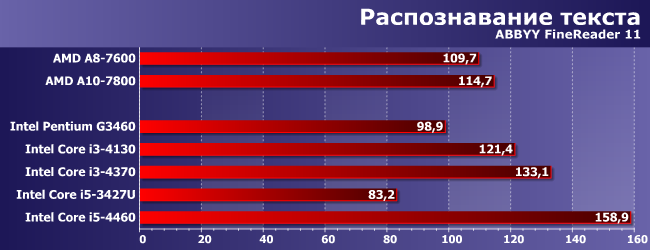
Here is a low clock rate Core frequency The i5-3427U does not allow you to feel its four-thread capabilities, although it still outperforms the G1820. But what’s more interesting is what’s in the desktop segment? And everything is predictable there: Core i3 regardless of frequency faster than processors AMD, Core i5 is also even faster regardless of it.
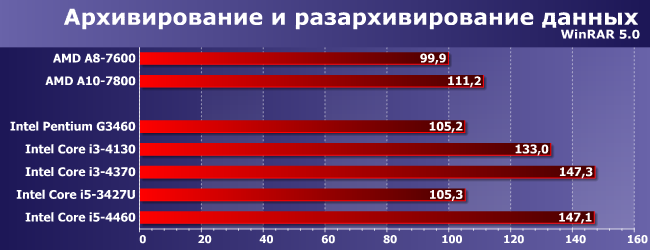
In archivers, multi-threaded packaging “pulls” upward multi-core processors, but unpacking is performed in one thread - and in the same way “pulls up” high-frequency processors. As a result, the most interesting thing is the practical equality of the older Core i3 and the younger Core i5.
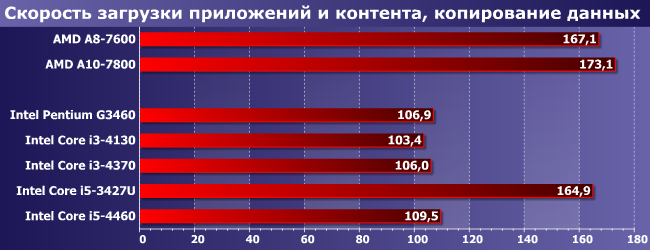
As we have already noted, the test started to run slowly on the LGA1150. Which, however, is not so critical - if you replace the fast solid state drive on a hard drive (and many still use them as the main and only ones; especially when finances are limited) - it will be many times slower: up to 20 points on any platform :) But with a fast one and within one platform, as we see, more powerful processor gives practically nothing: this is the main result from the point of view of testing processors.
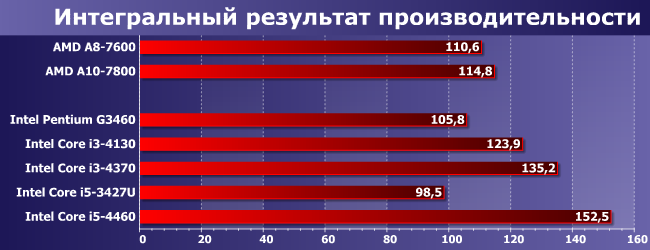
In general, the layout is simple. Even the junior Core i3-4130 is slightly faster than any AMD processor for Socket FM2/FM2+. But not much, so we can consider these processors to be approximately equivalent - as well as all dual-module AMD models. The advantage over Pentium is small, so it is quite possible to limit yourself to representatives of the latter family if you want to “wait inexpensively”. Well, or in cases where “inexpensive” is not too much of a concern, but compactness/autonomy is a big concern, ultramobile Core i5 will also provide a comparable level of performance. But they should not be confused with desktop Core i5s - they are one and a half times faster. The older Core i3s are somewhere between the younger i3 and i5, but closer to the former. For the price, however, too.
OpenCL
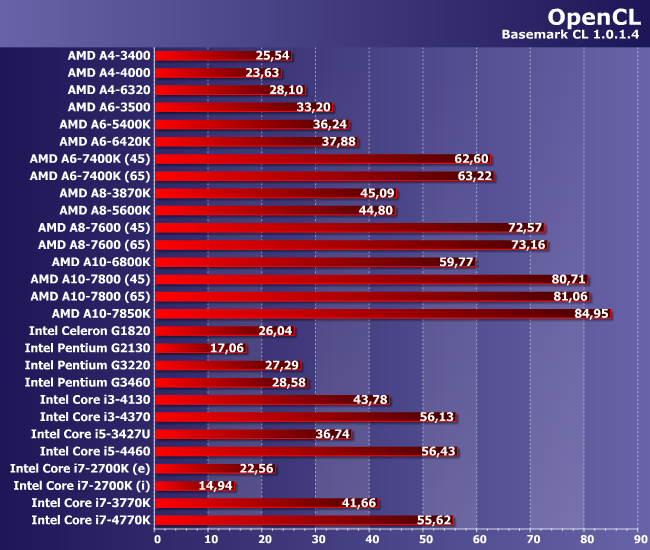
We have placed the Core i5-3427U here for now, since it is on par with many desktop models - which is not surprising, since its GPU is more powerful than those of “many” even more modern ones, and this test pays little attention to processor performance.
All three processors with HDG 4600 (i3-4370, i5-4460 and i7-4770K) behave the same, although they cost differently. In general, I again want to wipe away a stingy tear about the fact that in real applications everything is not at all as beautiful as in specialized test utilities, so you have to pay for “unnecessary” x86 cores and gigahertz.
Games
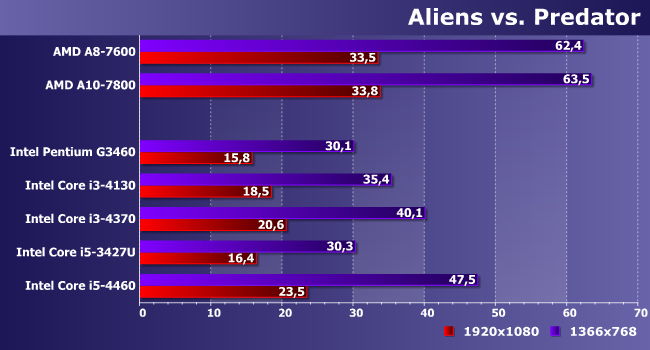
Actually, this is why they buy AMD APUs - you can play in FHD (even at minimum settings), and on Intel processors you can only lower the resolution. But at least it's already possible.
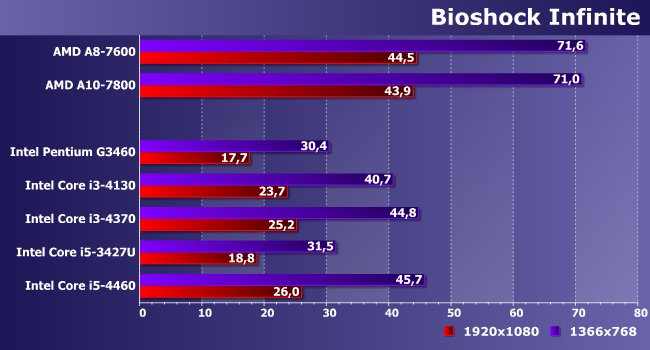
The picture is similar: HD Graphics, even in older versions, and integrated Radeons provide the same frame rate, but in different resolutions. “Somehow it’s possible” and “somehow it’s possible in FullHD” - briefly and clearly :)
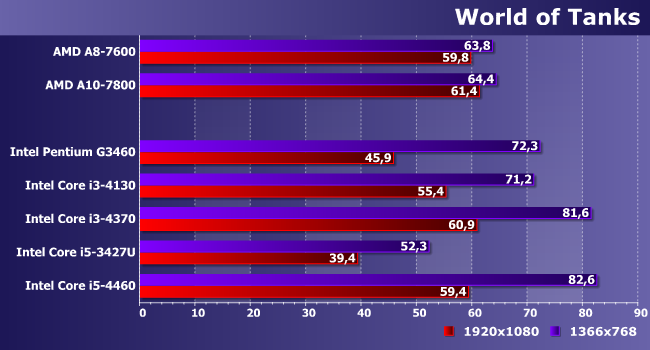
The only case where it provides a balm for the soul is that the HDG 4600 in mid-range processors even catches up with the Radeon in FHD, and in low resolutions the Pentium is already faster than AMD processors, but this is not such a common (albeit popular) case.
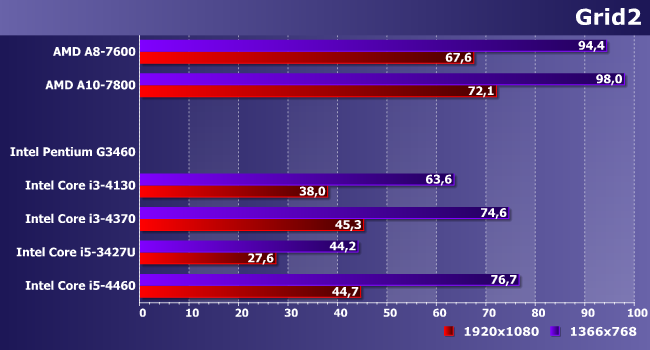
More often than not, this is already in the third game from the set.
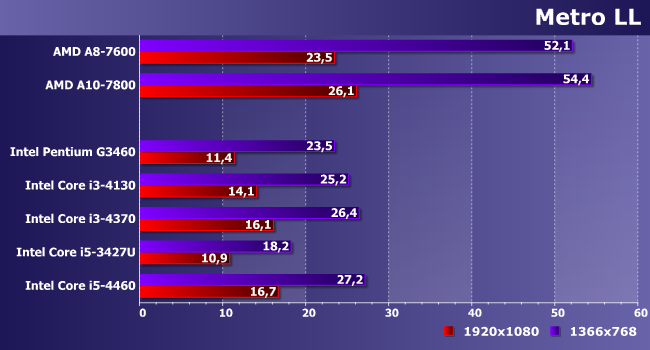
Well, the icing on the cake is when we compare “low resolution” and “not at all.”
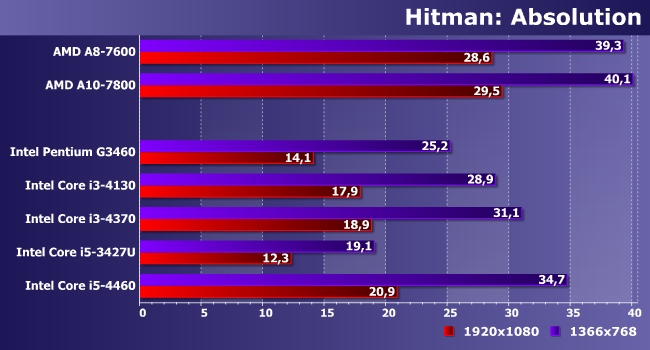
In Hitman it is a little easier, since the game is less demanding on the GPU. But all the same - AMD is already storming the peaks of full resolution, and Intel only passes the low level with some of its models.
In general, in a global sense, nothing has changed. Progress in terms of performance (and functionality) of integrated Intel graphics is quite noticeable, but there has been no fundamental change in the picture since the days of Llano. For now, if you still want to play some games without purchasing a discrete video card, AMD processors seem to be the more optimal solutions - they are simply faster and you can afford (as a result) a little more: both in terms of the range of games and in terms of settings.
Total
If the top Core i7 models are expensive, then many can afford a Core i3 or inexpensive Core i5. For what? And simply because they are faster than the same Pentium, but still not much more expensive. On the other hand, they are not many times faster, so you can save money. There are so many people - so many opinions. In any case, there is demand - there is never too much productivity. Moreover, the results of the Core i5-3427U clearly show that desktop computers are not in danger of dying at the hands of mini-PCs or laptops - they sacrifice compactness for performance and price.
But do not forget that when we talk about high performance, we mean precisely “processor” performance in mass-produced programs. The graphics core of the reviewed processors may be superior to the “numberless” HD Graphics, but it is not worth seriously considering it for regular use in games. It is better, however, to choose A8/A10 in this case or install a discrete video card - paired with a Core i3/i5 you will get a truly gaming computer.
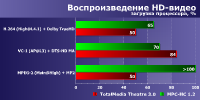
The question of the differences between processors of the Intel Core i5 and Intel Core i7 families arises for most users when choosing a PC or laptop with the stated characteristics, as well as when upgrading an existing system. With completely identical technical characteristics in the catalog or on the price tag (clock frequency, number of cores, cache size), the price difference reaches several thousand rubles. Naturally, a toad immediately appears and strangles the potential buyer, and he definitely wants to know why he is overpaying for and whether he needs it at all. Consultants, as a rule, cannot clearly explain how i5 processors differ from i7 processors. Probably because there are many models in both the i5 and i7 lines, and they are all different, although they are labeled the same. However, there are features common to models within the same line, and they can be considered, albeit not the main ones, but important selection criteria.
Intel Core i7 processors– a family of Intel processors based on the Nehalem microarchitecture, designed for LGA 1156/1366/2011 sockets. Used for high-end desktop systems, they have at least four cores in any modification.
Intel Core i5 processors– a family of Intel processors designed for mid-range systems. These processors are compatible with LGA 1155/1156 sockets, have two cores in the budget version, and four in the top version.
Intel Core i7 processors are said to provide better performance in demanding applications. In practice, it is not always possible to notice a difference in performance, and often the performance increase remains the prerogative of test benches exclusively.
The most important and obvious Intel difference Core i7 from Intel Core i5 – the first to support Hyper-Threading technology, which allows each core to serve multiple threads. The quad-core i7 processor supports 8 threads, which is equivalent to the performance of eight cores. Intel Core i5 does not support this technology (with the exception of the i5-661 model). Intel Core i5 can be dual- or quad-core, Intel Core i7 can be four- or six-core.
The L3 cache in Intel Core i7 processors can reach 12 MB, while in Intel Core i5 it is limited to 8 MB. Controller random access memory i7 can be three-channel (LGA 1366) and dual-channel (LGA 1156), while i5 only works with two channels. Intel Core i7s work with QPI buses, while i5s work exclusively with DMI.
The maximum clock speed of processors from the Intel Core i7 family is slightly higher than that of models from the Intel Core i5 family. True, in real work these numbers play practically no role - there is no noticeable increase in performance due to an increase in frequency. But the heat dissipation of i7 processors in normal mode can be higher than that of i5 processors (up to 130 W), with the same 45 nm process technology.
Intel Core i7 processors are always more expensive than Intel Core i5. This is due to the marketing tricks of the company, positioning the i7 as top components for high-end systems.
Difference between Intel processors Core i7 and Intel Core i5 are as follows:
- Intel Core i7 are positioned as processors for high-end systems.
- The maximum number of cores in Intel Core i7 is six, while in Intel Core i5 it is four.
- Intel Core i7 support Hyper-Threading technology.
- The heat generated by some Intel models Core i7 is higher.
- The performance of Intel Core i7 in tests is higher than that of i5.
- Intel Core i7 can work on the QPI bus and with a three-channel memory controller.
- Intel Core i7 is more expensive.
Call or directly on the website! Our specialists will be happy to help you!
Computer progress does not stand still; more and more new technologies are constantly appearing. Not everyone these days can explain the difference between one processor model and another. Let's try together to figure out the difference between the two most popular processor models today, Intel Core i3 and Intel Core i5.
Intel Core i3– latest generation dual-core processor. Originally designed for desktop computers entry level. The processor is equipped with a built-in dual-channel DDR3-1066/1333 RAM controller with voltages up to 1.6 V. It is important to note that modules that are designed for higher voltages will not function with this chip, in addition, they can damage it. The processor is equipped with a built-in PCI Express 2.0 x16 controller, with which graphics accelerator can be connected directly to the processor. DMI bus with throughput 2GB/s is used to connect to the set system logic. The i3 processors have a built-in GMA HD graphics core with a clock frequency of 733 MHz and twelve pipelines. However, the base clock speed for all Core models i3 is equal to 133 MHz, nominal frequencies are achieved by using multipliers.
Intel Core i5– latest generation dual or quad core processor. Originally designed for mid-range desktop computers. The processor is equipped with a built-in dual-channel DDR3-1066/1333 RAM controller with a voltage of up to 1.6 V. A DMI bus with a bandwidth of 2 GB/s is used to connect to the system logic set. The processor is equipped with a built-in PCI Express 2.0 x16 controller, with which the graphics accelerator can be connected directly to the processor. However, in models equipped with a GMA HD graphics core, you can connect one video card in x16 mode to the chip, and if the model does not have built-in graphics, then two video cards in x8 modes each. Dual-core models feature Hyper-Threading technology. It is worth noting that if the model number ends with 1, then the graphics clock speed will be 900 MHz, and if it ends with 0, then 733 MHz. All i5s feature Turbo Boost technology that automatically increases clock speeds at resource-intensive levels.

differences between Intel Core i3 and Intel Core i5:
- i5 processors have 2- and 4-core versions, while i3 processors have only 2-core versions.
- L3 cache memory in i5 processors is 4 or 8 MB, common to all cores, in i3 it is only 3 MB.
- The i5 processor supports Turbo Boost technology.
- The built-in PCI Express 2.0 controller in i5 can have one x16 or two x8 lanes; in i3 processors there is only one x16 lane.
- The i5's integrated graphics can be clocked at 900 MHz, as opposed to the i3's clock speed of 733 MHz.
So what should you choose? Which model is better?
As can be seen from the comparison, these chips are very similar. Core processors i3 is quite powerful and at the same time inexpensive, ideal if you are strictly limited on budget. Core i5 600 series processors have high performance, however, they have a chip with integrated graphics. These models are aimed at office workers who do not need powerful graphics. Quad-core i5-750 is the most the best choice if you want to collect powerful computer for reasonable money.
Call or directly on the website! Our specialists will be happy to help you!
When in 2010 year Intel introduced the trade names Core i3, i5 and i7 for the main computer chips, there were many who were confused by this. The company's end goal was completely different - with this distinction between processor lines, it attempted to offer a quick and easy way to identify low-, mid-, and high-end models. Intel's idea was to attract users' attention with the following message: "Core i7 processors are better than Core i5, which in turn are better than Core i3." Unfortunately, this does not answer the question of why some are better than others and how they differ.
After 2010, Intel further confused its consumers by releasing a number of new generations of processors based on different architectures: Sandy and Ivy Bridge, Haswell, . Despite the use of new production technologies, the trade names Core i3, i5 and i7 have not changed. The reason for this has more to do with the fact that the main differences between them remain the same: i3 chips are designed for computer systems base class, i5 for mainstream computers, and i7 for the most powerful gaming PCs or machines for serious photo/video work.
In this article I will try to explain some of the main differences between these processor classes.
Key Technologies
Let's start by debunking one very popular misconception - the names i3, i5 and i7 have nothing to do with the number of processor cores. These numbers were chosen more or less arbitrarily by Intel, and all of its mainstream chips actually contain between two and four cores. Only a few super high-end desktop models offer more. The main differences between the three lines lie elsewhere, namely the support of several key proprietary technologies - individually or in combination with each other.
These include:
Hyper-Threading
At the dawn of microprocessor technology, all processors had one core, which executed only one set of instructions (thread). The desire to increase the efficiency of computing operations led to an increase in the number of physical cores (up to two, four, and then more). This allowed processors to work in parallel with a larger number of “threads” and perform more work per unit of time.
The next logical step for Intel was to further optimize this process. Thus was born Hyper-Threading technology, which allows one physical core to process more than one set of instructions (threads) simultaneously. In other words, a dual-core chip with Hyper-Threading support can be thought of as a processor with four (albeit virtual) cores.
Turbo Boost
There was a time when processors operated at a fixed clock speed. In other words, their internal clock, counting data processing cycles, “ticked” at a certain, constant speed set by the manufacturer. The only way to change this speed is called “overclocking”: it requires special knowledge, plus it carries a real risk of causing irreparable damage to the processor.
Today everything is completely different. Almost all modern processors(especially models designed for mobile computers) operate with a variable clock frequency (speed), which changes depending on the load. This results in higher energy efficiency and longer service life. battery life mobile devices.
Cache size
All modern processors, regardless of brand and model, work with data. Many of the operations performed are routine, i.e. the same data is used over and over again. To speed up the processor, they are stored in a special high-speed buffer. Thus, when requested by the processor, this data becomes available almost instantly, since it does not have to read it again and again from the computer's disk or RAM.
IN different processors Cache size varies over a relatively wide range. In low-end models this is about 3-4 MB. In high-end chips, the cache size reaches 6-12 MB.
Typically, the larger the cache memory, the more efficient the corresponding processor is. However, this "rule" does not apply universally to all types of applications. For example, photo and video editing programs will readily take advantage of the processor's large cache. The principle of their operation involves the reuse of identical instructions (data sets), so a large cache size has a positive effect on their performance.
However, when performing general tasks (like browsing the Internet or running office applications), the cache size has a much more modest, often negligible, impact.
Briefly about the types of Intel processors
Now that we've covered the main differences between the three classes of Intel processors, it's time to look at the descriptions of each:
Intel Core i3
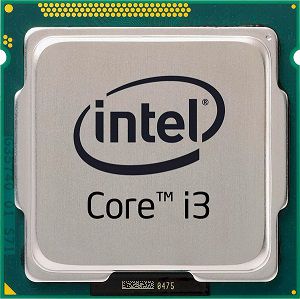
Suitable for: Everyday work. Ensures smooth and fast execution of work-related tasks office applications, browsing the Internet and streaming video in HD quality.
A brief description of: The most affordable class of processors in the Intel Core family. Offers up to two physical cores and Hyper-Threading technology for virtual multi-threading. They don't support Turbo Boost, but their power consumption is relatively modest, so laptops that use them usually boast long battery life.
Intel Core i5
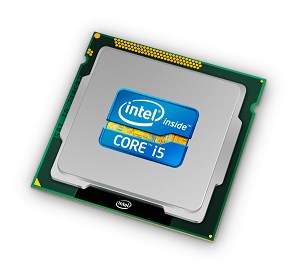
Suitable for: Intensive work with several applications simultaneously to process digital photos and videos at home. Suitable for most modern games.
A brief description of: Processors designed for mid-range desktop computers and laptops. They offer from two to four physical cores, but not all models support Hyper-Threading. They have a Turbo Boost function, which increases the frequency under heavy loads.
Intel Core i7
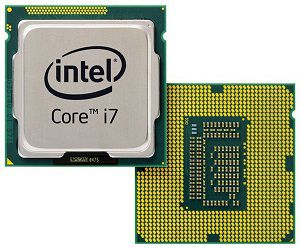
Suitable for: 3D modeling, heavy video processing applications (high and ultra-high resolution 4K video editing) and the most advanced 3D games.
A brief description of: The highest class of chips that the company offers. They are available in versions with two, four, six and eight cores, and support Hyper-Threading and Turbo Boost.




